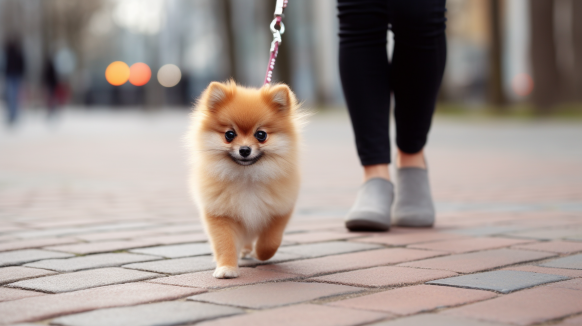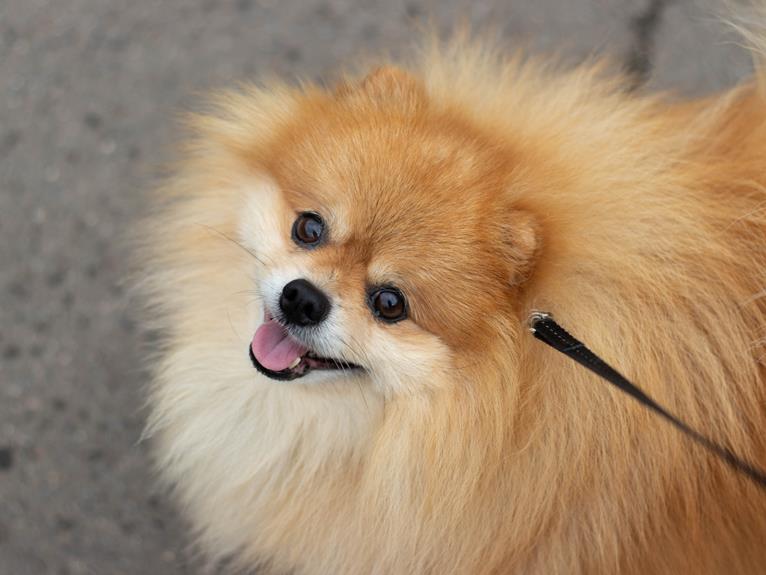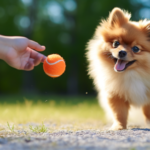Are you looking for the ultimate guide to mastering pomeranian leash training? You’re in the right place.
In this guide, we’ll cover everything you need to know to help your pup learn how to enjoy walks with you, including:
- Choosing the right leash
- Acclimating to the leash
- Backyard trials
- Rewarding good behavior
- Introducing distractions
- Building endurance
- Recalling commands
- Social walks in different weather conditions.
Get ready to enjoy your walks with your pup!
Key Takeaways
- Choose a leash made of a suitable material and consider the size and type of leash for your Pomeranian.
- Gradually acclimate your Pomeranian to the leash, increasing the duration of walks and rewarding positive behavior.
- Conduct backyard trials with different leash lengths, using reward strategies to reinforce good behavior and ensure comfort and durability.
- Reward good behavior using praise, treats, toys, and positive reinforcement techniques, incorporating clicker training for effective communication.
Choosing the Right Leash
Now that you’ve decided to start leash training your Pomeranian, it’s time to choose the right leash.
When selecting a leash, consider the material it’s made of, the size and type, and the collar selection.
Many owners prefer a leather leash, as it’s strong and durable, withstanding weather and wear and tear. Nylon is also a popular choice as it’s lightweight and adjustable.
Retractable leashes are great for giving your pup freedom to explore, although it’s important to use caution with these types of leashes.
Harnesses are great for smaller breeds, as they evenly distribute the weight and provide more control.
Finally, be sure to check the collar selection, as some models come with a built-in leash.
With the right leash, you and your pup will be mastering the basics of leash training in no time.
Acclimating to the Leash
Getting your pup used to the leash can be a challenge, but with the right approach, you’ll be mastering it in no time. To increase leash comfort and confidence, try these steps:
- Start by attaching the leash to your pup’s collar and let them get used to the sensation.
- Gradually increase the duration of walking while rewarding positive behavior.
- Monitor your pet’s behavior and look for signs of stress.
- Praise good behavior and reward with treats.

Backyard Trials
Once your pup has mastered the basics of leash training, it’s time to move on to backyard trials.
Start by experimenting with different leash lengths.
Then, use rewards strategies to reinforce good behavior and remind your pup of the boundaries.
Leash Lengths
Frequently, you’ll want to try out different leash lengths in your backyard to get your Pomeranian used to walking on a leash. Generally, you should choose a leash material that won’t irritate your pup’s skin, such as leather or cotton. The recommended lead length should be between 4 and 6 feet.
Here are some tips to consider when choosing the right leash for your pup:
- Comfort: Make sure the leash fits comfortably and won’t cause discomfort.
- Durability: Select a leash that won’t break easily and can withstand wear and tear.
- Visibility: Choose a leash that’s visible in low light conditions.
- Attachments: Check for secure attachments that won’t detach easily.
Rewards Strategies
Once you’ve established a suitable leash length, try out different rewards strategies in your backyard to get your Pomeranian used to walking on a leash.
Start by introducing positive reinforcement techniques, like giving your pup a treat or verbal praise after each successful walk. This will help them quickly learn that leash walking is associated with something pleasurable.
Once your pup is familiar with the concept, you can move on to reward schedules. This involves providing rewards only after certain criteria is met, such as walking a certain number of steps or mastering a particular skill. This method can help you effectively motivate your pup and increase their leash walking confidence.
As you experiment with different rewards strategies, remember to be patient and always use a kind and encouraging tone. With the right approach, you can have your Pomeranian mastered leash training in no time.
Boundary Obstacles
Once you’re confident in your pup’s leash walking skills, try setting up boundary obstacles, like chairs or small fences, in your backyard to test your Pomeranian’s progress.
Boundary obstacles are great for teaching your pup to listen to you on distraction free walks, while also preparing it for sudden noises in public spaces.
Here are some tips for using boundary obstacles:
- Start with smaller boundaries and gradually make them larger.
- Reward your pup for staying within the boundaries.
- Avoid punishing it for stepping outside the boundaries.
- Redirect its attention to the boundaries when it starts to wander.
With regular practice, your Pomeranian will soon be able to walk on a leash with ease and confidence.
Rewarding Good Behaviour
Rewarding good behaviour is an essential part of mastering Pomeranian leash training. Using reinforcement strategies and positive reinforcement, you can effectively encourage your pup to continue performing the desired behaviour.
This will help you and your furry companion master the leash in no time.
Reinforcement Strategies
Using consistent reinforcement strategies is an essential part of mastering Pomeranian leash training. A few of the most successful include:
- Praise-based training: This is the simplest way to reward your pup for positive behaviors. Offer kind words and lots of petting to reinforce good behaviors.
- Clicker training: Using a clicker can help you better communicate with your pup. Each time your dog does the right thing, click and reward with a treat.
- Treat-based training: Treats can be used as rewards for good behavior. Make sure to offer treats in moderation.
- Toy-based training: Toys are a great way to reward your pup. When your pup does something right, give them a toy to play with.
Positive Reinforcement
By utilizing positive reinforcement, you can reward your Pomeranian for good behavior. Positive reinforcement techniques involve providing an immediate reward such as a treat or verbal praise when the desired behavior is exhibited. This helps to reinforce the behavior and increase the likelihood that it will be repeated.
A reinforcement schedule can be implemented to ensure your Pomeranian is regularly rewarded for good behavior. This can include offering treats after a certain period of time or number of behaviors. The key is to make sure the rewards are given immediately and consistently.
To ensure the most successful training, use positive reinforcement in combination with other techniques such as redirection and consistent structure. Your Pomeranian will quickly learn that good behavior is rewarded and will be more likely to repeat it in the future.
Introducing Distractions
Once you’ve gotten your Pomeranian used to the leash, it’s time to introduce distractions. This will help ensure your pup is comfortable in a variety of situations and can remain calm in the presence of triggers. To do this safely, it’s important to understand the materials used for the leash and the types of distractions your Pomeranian may encounter.
- Start with a lightweight leash made of materials that won’t cause discomfort.
- Introduce distractions gradually. Start with low-level distractions such as people walking by and work your way up to higher level distractions such as loud noises.
- Make sure there are plenty of rewards. Give your pup treats and verbal praise when they remain calm and focused.
- Take regular breaks. Allow your pup to take a break when they become overwhelmed.
Building Endurance
As you build your Pomeranian’s leash endurance, both you and your pup will need to remain patient and take breaks. Progressively increase the amount of time spent on the leash, but don’t push them too far. Add in distractions such as other people, animals, and objects to mentally stimulate your pup. Ensure they’re comfortable with each step before moving on to the next.
Start with short walks and gradually increase the length as your pup is ready. Keeping the duration of the walks short is essential for your pup’s comfort and safety. Additionally, make sure that your pup takes plenty of breaks to rehydrate and rest.
With gradual, progressive steps and regular mental stimulation, your pup will soon be a master of leash training.
Recalling Commands
You can help your Pomeranian recall commands to make leash training even easier. To do this, it’s important to provide positive encouragement and verbal cues:
- Use a happy tone when giving commands.
- Reward good behavior with treats or pats.
- Repeat the commands if your Pomeranian doesn’t respond.
- Praise your Pomeranian when they do respond correctly.
Be sure to reward and praise your Pomeranian each time they successfully recall a command. This will help to strengthen the bond between you and your pet, and will make leash training even more enjoyable.
With patience and consistency, your Pomeranian will soon be able to recall commands with ease.
Social Walks and Different Weather Conditions
No matter the weather, taking your Pomeranian for social walks can be an important part of leash training. It’s important to be conscious of your pup’s safety and leash etiquette, so be sure to take weather safety precautions.
If the weather is too hot, consider going out early in the morning or late in the evening when it’s cooler. If it’s raining, bring a raincoat for your pup to keep them dry. In cold weather, be sure to have a warm coat on hand.
Always bring a water bottle and bowl for your pup, as well as a few treats for when they behave well. Make sure to take breaks to rest and stay hydrated.
Frequently Asked Questions
How Long Should I Spend Leash Training My Pomeranian Each Day?
Spend 15-20 minutes daily leash training your Pomeranian, using motivating rewards and positive reinforcement. Keeping sessions short and fun will help ensure success.
Is There a Particular Age That Is Best for Leash Training a Pomeranian?
Yes, an ideal age for leash training a Pomeranian is around eight to twelve weeks. Socialization is key, so consistent, positive reinforcement with treat rewards can help them learn quickly.
Is It Better to Use a Harness or a Collar With a Leash to Train a Pomeranian?
When leash training a Pomeranian, it’s best to use a harness. Positive reinforcement and reward-based approaches are essential and a harness gives you more control, helping to avoid negative behaviors. Make sure to choose one that fits correctly for optimal results.
What Should I Do if My Pomeranian Is Afraid of the Leash?
If your Pomeranian is afraid of the leash, start by familiarizing them with the environment and use positive reinforcement. Speak in a calm, comforting tone and offer treats to show they are safe and loved.
How Can I Tell if My Pomeranian Is Making Progress With Leash Training?
You can tell your Pomeranian is making progress if they are responding positively to positive reinforcement and showing reduced signs of fear. Track their progress and adjust your leash training techniques accordingly.
Conclusion
You’ve learned the basics of mastering pomeranian leash training. From choosing the right leash, to acclimating your pup to it, to introducing distractions, building endurance and social walks, you’re well on your way to having a well-behaved pup.
If you keep up with the rewards, commands, and practice, your pup will be a leash-trained pro in no time!






